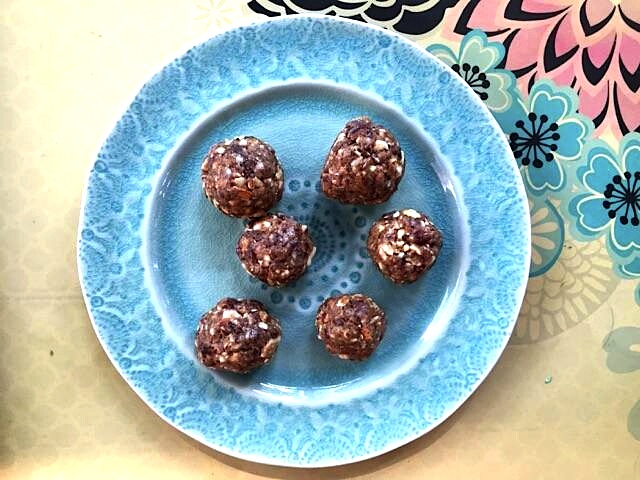You’re Sweet Enough Already
/Rethinking Sweeteners from The Physician’s Kitchen
 By Avery Morrison, special to Edible DC
By Avery Morrison, special to Edible DC
Entering Casey Health Institute (CHI) feels like a peaceful utopia as you enter fresh from the bustling traffic of rush hour. I had braved after-work traffic to attend the last of Casey Health’s Physician’s Kitchen series for the summer (don’t worry, they resume in mid-September. Click HERE for more information.) The Physician’s Kitchen series is run by the physicians at CHI who truly believe in the food-as-medicine approach to diet and health. Each session begins with a lecture and ends with a demonstration and tasting. The topic of the lecture changes each session, but the entire series focuses on the powerful influence of food on the body and how to use food to get and stay healthy. After the classroom setting, there is a cooking demonstration, tastings, and the recipes are shared so that the all the information from the lecture gets hands-on reinforcement.
It starts with using the best ingredients. Almost all the food used throughout the series comes from a local CSA, and CHI is also a distribution center for that CSA. Additionally, they are conscious about food waste; any extra food is sent to Manna, a nonprofit that feeds the hungry in Montgomery County.
The lecture I attended focused on sweeteners, both good and bad. I come from a family of Splenda and Crystal Light power users and I was in for a big surprise. ‘Artificial Sweeteners are bad’ was something I had heard before, but finally, someone gave me an explanation why. The lector, Dr. Carrie Runde, told us of the negative side effects and the science behind why artificial sweeteners aren’t great for us, but most important for my demanding sweet tooth, she gave us roughly 15 alternatives.
After the lecture, we went back into the kitchen where we tasted raw energy balls and fruit skewers with caramel sauce, both amazing and filling—and great after school snacks or to take for a work lunch. They follow this article.
At the session ended, there was an contest featuring CSA produce as a prize for correct answers regarding food and health. Leaving with a fresh bunch of exotic basil, I vowed to get rid of the Splenda and Crystal Light lurking in my kitchen, and replace it with Stevia and other natural sweeteners. If you are interested in doing the same, I’ve shared a few natural sweeteners and the conversions Casey Health provided at the lecture series at the end of this article. And thanks to Casey Health for sharing the easy recipe for Raw Energy Balls, perfect for a healthy option for school snacks or lunch.
Raw Energy Balls Total Time: 15 min Makes about 1 dozen balls
1 cup raw almonds (or pecans or walnuts) 1 cup pitted dates (or dried apricots) ¼ cup raisins ¼ teaspoon cinnamon ¼ teaspoon ground cardamom ¼ cup raw almond butter (or another nut butter) Shredded unsweetened coconut or cocoa powder
Grind almonds in a food processor until finely ground. Add the dates, raisins, and spices. Grind to a fine meal. Add almond butter and process again until thoroughly mixed. Form into balls and in the Edible DC test kitchen, we liked them rolled in shredded coconut. Cocoa powder works too. Adapted from The Whole Life Nutrition Cookbook.
Natural Sweeteners and Conversions
| Sweetener | Amount to replace 1 cup sugar | Adjustments to recipe |
| Agave | ¾ cup | Reduce liquid in recipe by ⅓ to 1/2 . Reduce baking temperature by 25˚ |
| Barley Malt Syrup* | 1 ⅓ cups | Reduce liquids by 1/4 . Add ¼ teaspoon baking soda for each cup syrup to help baked goods rise.** |
| Brown Rice Syrup* | 1 ¼ cups | Reduce liquids by ¼ and add ¼ teaspoon baking soda for each cup syrup to help baked goods rise.** |
| Date Sugar | 1 cup | None |
| Frozen juice concentrate | ⅔ cup | Reduce liquids by ⅓ and add ¼ teaspoon baking soda per cup of concentrate. ** |
| Honey | ½ cup | Reduce liquids by ⅛. Reduce oven temperature by 25 degrees and cook a bit longer. |
| Maple Syrup | ½ to ⅔ cup | Reduce liquid by ¼ and add 1 teaspoon baking soda per cup of syrup. ** |
| Molasses | 1 ⅓ cup sweet molasses | Reduce liquid by 6 tablespoons and add ½ teaspoon baking soda per cup of molasses. *** |
| Stevia | Read labels for powder, liquid or concentrate | Follow suggestions on product label |
| Sugar cane juice | 1 cup (Rapadura, Sucanat, muscovado, turbinado, demerara) | None |
| Xylitol or Zero | Granulated 1 cup | None |
*If you use barley malt of brown rice syrups in baked goods, be aware that a natural enzyme in these sweeteners may liquefy the consistency of the batter. This is more likely when eggs are not used. To prevent liquefying eggless recipes, first boil the barley malt or brown rice syrup for 2 to 3 minutes, cool, then measure and use. **For each ¼ teaspoon baking soda, reduce salt by ¼ teaspoon. ***Do not substitute more than half the sugar in a recipe with molasses, blackstrap molasses is not sweet.
For any questions, concerns or more info about the CHI CSA, email wellness@caseyhealth.org
Casey Health Institute (and the CSA pick up location), 800 S. Frederick Avenue, Gaithersburg, MD 20877, 301-644-6464, caseyhealth.org
 Avery Morrison is a contributor to Edible DC and summer intern. An award-winning student writer, she is a sophomore at UVA and plans to study medicine.
Avery Morrison is a contributor to Edible DC and summer intern. An award-winning student writer, she is a sophomore at UVA and plans to study medicine.




